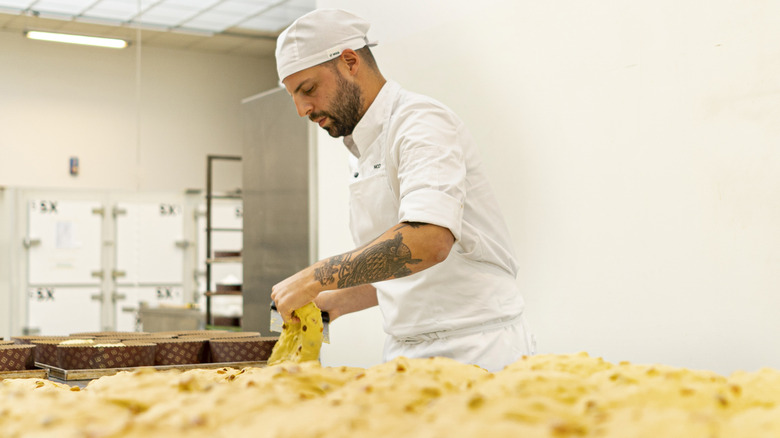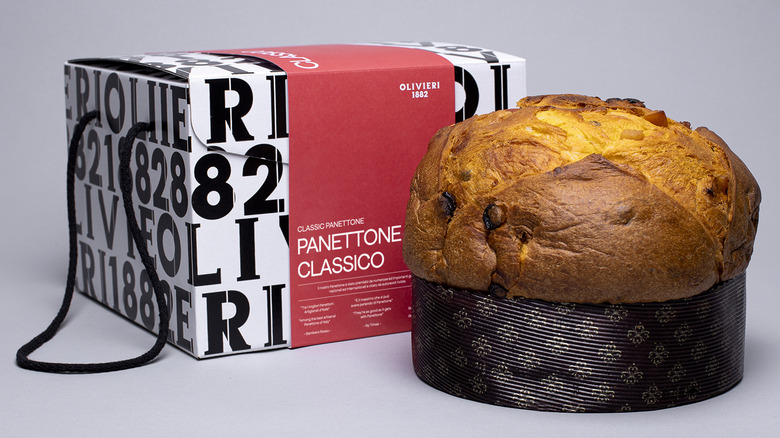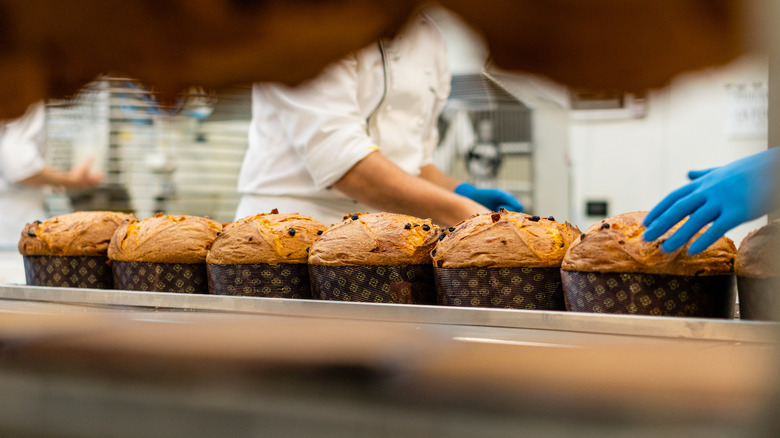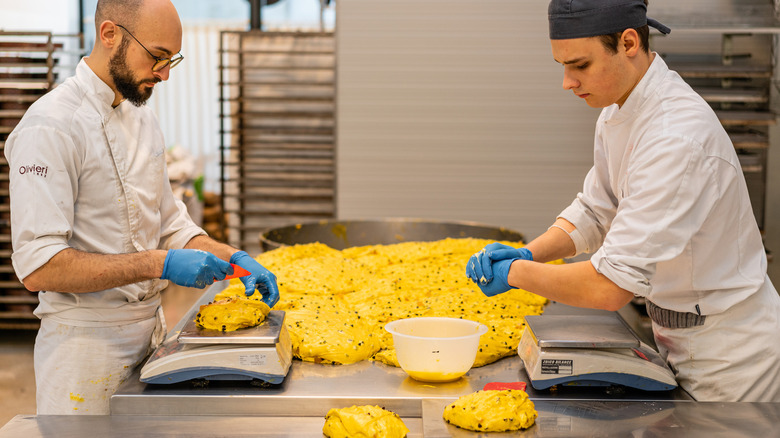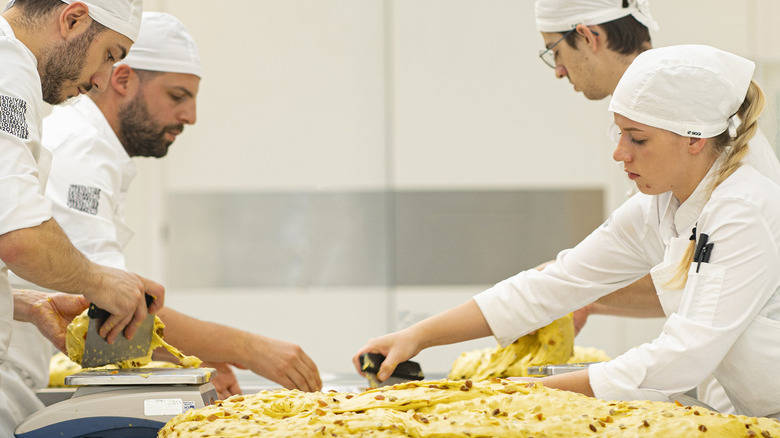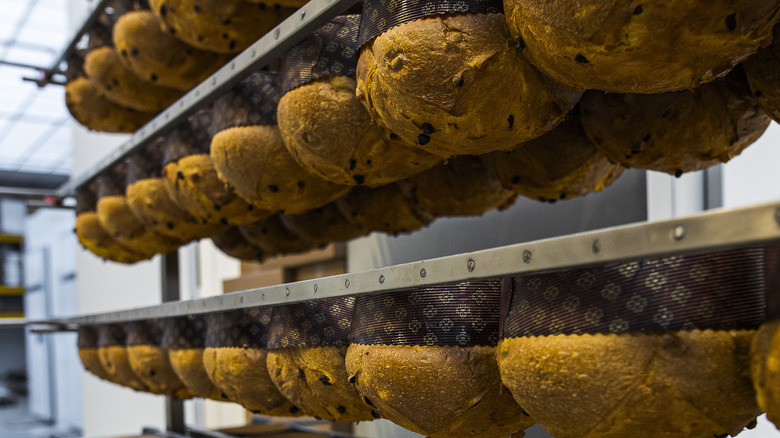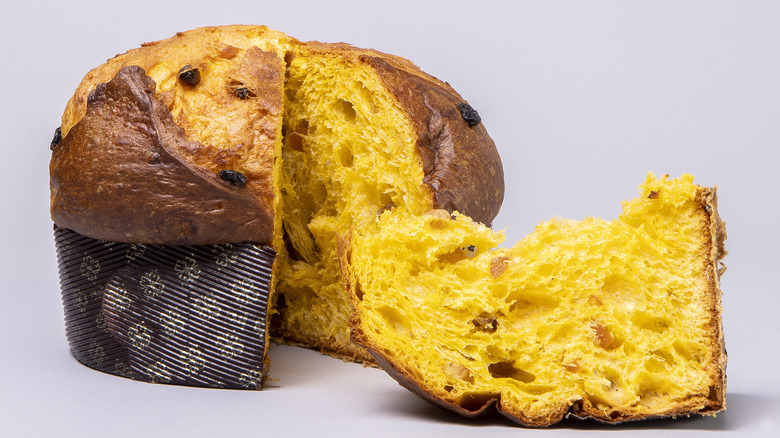Pastry Chef Nicola Olivieri's 6 Tips For Making The Fluffiest Panettone This Holiday Season
It isn't Christmas in Italy without panettone, a pillow-soft, domed-shaped sweet bread studded with chocolate and candied fruits such as raisins and oranges. In recent years, the seasonal bread achieved fame in countries such as the United States, where large and small packages of the dessert are now ubiquitous in grocery stores.
But, there is one panettone that reigns supreme in Italy, that of the intergenerational bakery Olivieri 1882. The family-run bakery opened in 1882 and is headquartered in Arzignano, a city in the northern region of Veneto. Nicola Olivieri now runs productionand the meticulous panettone is one of the bakery's most popular desserts — with over 50,000 being shipped within Italy every holiday season. And, year after year, including in 2023, the bakery wins a slew of awardsfor being among the best artisan panettone in the country.
Olivieri 1882 churns out traditional, handmade panettone derived from a generational recipe, but also makes revisited options such as apricot and salted caramel, pear and dark chocolate, and sour cherries and pistachios, all of which can be shipped to the U.S. within 48 hours. Prices range from $75 to $85, at the time of publication, not including shipping fees.
We spoke with Olivieri, who shared his six tips for making the fluffiest panettone at home this holiday season.
Use only the best ingredients
A panettone is only as good as its ingredients. "This meticulous selection of materie prima, or raw materials, truly differentiates a good panettone from a great one," says Olivieri. The pastry chef adds that the simplest ingredients, like butter and eggs, and the more intricate ones like chocolate and vanilla, each play an integral role in the taste and texture of the dessert.
That's why Olivieri 1882 sources high-quality products such as Madagascar Bourbon vanilla bean and ultra-savory Belgian butter. The Olivieri panettone also includes Italian acacia honey, raw cane sugar, and candied oranges that are cut and candied in-house. Australian five-crown sultanas, which are a sweeter cousin to the raisin, round out this traditional version of the Christmas dessert.
The bakery's twist on a traditional Italian panettone recipe, which has been dutifully passed down through the generations, ]contains up to four times more eggs than regular panettone recipes, according to Olivieri. This almost ludicrous amount of eggs gives the cakes a richer flavor and texture, as well as a bright yellow color. In other words, don't be afraid to give your dough a supremely healthy dose of fresh, organic eggs –- it'll be worth it later.
Look after your mother dough
Lievito madre, known as mother dough or simply as a starter, is made with only flour and water. Olivieri 1882 specifically uses type 00 flour, which has been finely milled and is very elastic. Similar to a sourdough starter, the mother dough requires a lot of patience and is key to the success of your panettone. The long fermentation process ensures that the product is overall more digestible, according to Olivieri. Because of the natural fermentation provided by the explosion of yeasts and various species of bacteria, the product guarantees better leavening and can be stored for longer, he adds.
This living dough is refreshed by adding equal amounts of flour and water. "The mother dough is absolutely sacred," Olivieri says, adding that it's monitored by staff throughout the day and left to rise for nine to 10 hours. "It's alive, not in a dehydrated powder. ... Having a natural mother dough that is alive can be difficult to tend to, particularly in the hotter summer months but also when the temperature plunges in the winter."
Even when the bakery is closed, the staff takes turns refreshing it. "It's only with great experience and finesse that we are able to make our mother dough consistently flourish and be at its best in every season," says Olivieri. If, by chance, the mother dough is neglected, the chef says it can end up ruining the flavor of the panettone, making it taste sour or cheesy.
Pay close attention to the proofing temperature and time
Once the mother dough is ready, it's added to the panettone dough, alongside dry and wet ingredients such as sugar and butter. This conjoined dough should be left to rise for 14 hours, at which point it triples in size. The aromatic ingredients, including vanilla, fruits, and candied paste, are then added before the dough is left to rise for an additional hour. The dough is then weighed, cut, vigorously hand-shaped into balls, and placed into molds.
Closely monitoring the proofing temperature and time of your panettone is essential to achieving that sky-high dome shape and moist, fluffy interior. Patience and time are naturally required. While recipes may advise leaving the dessert to rise at roughly 86 F for anywhere between five and six hours and then baking it to make up for time, Olivieri recommends a much lengthier proofing process. The bakery leaves its panettone to rise for at least 24 hours, at a slightly lower temperature. Giving the panettone plenty of time, says Olivieri, will allow the interior to truly soften and for the flavors to languidly leach out and saturate the entire product. "This makes our panettone softer, more flavorful, and more digestible," he says.
Although a dessert, it is this very delicate process of leavening and proofing that technically classifies this dessert as bread — panettone in English roughly translates to "big bread."
Don't forget about the scarpatura
Before the risen dough can be popped into the oven to bake and reach its full, delicious potential, Olivieri stresses the importance of the scarpatura. Roughly translating to "shoeing," scarpatura is the process by which a cross shape must be delicately cut into the dessert's surface with a finely serrated knife.
The flaps of these four cut sections must then be gently pulled back to cut the dough once again with a cross shape, which Olivieri says is an ode to Christianity and the Christmas-time birth of Christ. Pieces of softened butter can be placed in between these flaps to add further flavor to the dessert. All cut sections must be folded back over each other before baking.
Cutting the dough will ensure that the panettone develops well in the oven and achieves that perfect round shape. Then, and only then, is the panettone ready to bake.
Remember to flip your panettone upside down
Perhaps the easiest part of this gargantuan effort is the direct baking in the oven. A panettone can be baked in the oven for one hour at roughly 300 F — an easy feat compared to the rest of the process. However, once the panettone is taken out, it must immediately be flipped upside down. The rich, thickness of the dough would cause the structure to collapse internally if not swiftly turned, ruining hours and hours of hard work.
At professional bakeries like Olivieri 1882, there are specialized revolving metal structures that allow for rows upon rows of panettone to be hung upside down. Brave souls seeking to take on the process at home will need to get creative. Try balancing your dessert between shelves or even pots and pans –- anything that will allow for it to hang upside down undisturbed for a good amount of time.
Olivieri recommends that the panettone should be hung upside down to cool for 12 to 14 hours to ensure the integrity of the dessert's shape.
Serve your panettone correctly
The panettone-making process doesn't simply end at successfully leavening, flavoring, proofing, and baking it. There is also a correct way to cut and serve the dessert, says Olivieri. He recommends always using a serrated knife to effortlessly cut desired swaths of the fluffy sweet bread when serving. After all the work that went into making the panettone, it shouldn't be mutilated upon tasting.
Olivieri also suggests popping the panettone back into the oven for a few minutes at serving time to allow for it to release its delightful vanilla and citrus aroma. And, if there happen to be any leftovers, it can be repurposed into something equally delicious -– panettone french toast. The ultimate holiday breakfast, panettone French toast can be topped with whipped cream, vanilla ice cream, maple syrup, or candied pecans. As panettone is naturally soft and fluffy and freckled with dried fruit, pieces must be thoroughly soaked in batter ahead of searing to ensure that they don't fall apart in the pan.
Overall, Olivieri preaches practicing patience when it comes to making the fluffiest panettone this holiday season. At Olivieri 1882, it takes a full four days from start to finish to achieve its award-winning product. There are simply no shortcuts when it comes to making this famed Italian Christmas dessert. But, the effort is undoubtedly worth the sweet reward.
